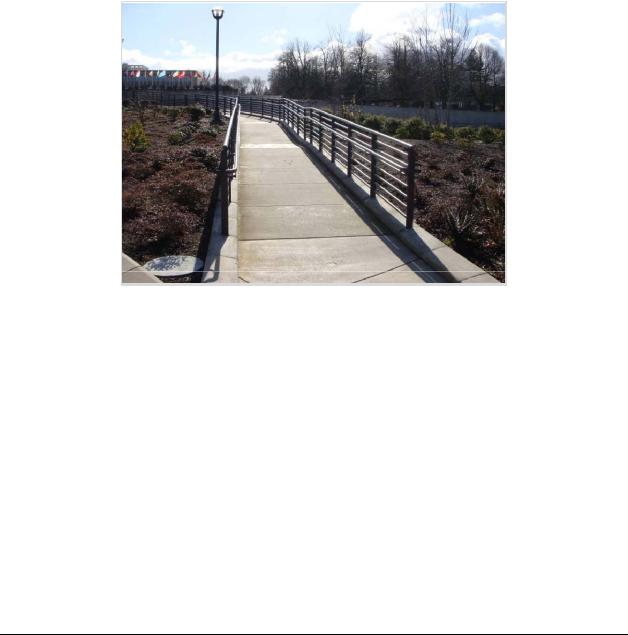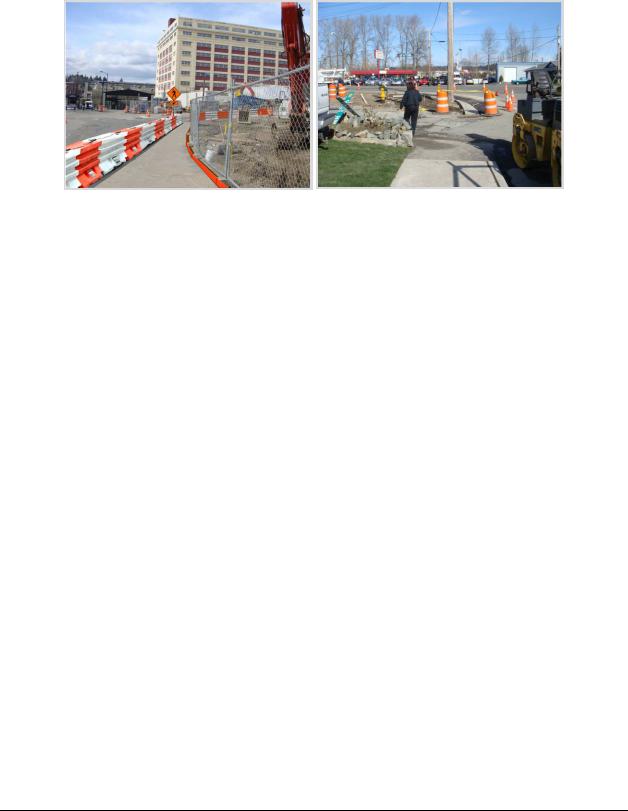
1510
.pdf
Chapter 1510 |
Pedestrian Facilities |
|
|
An access ramp landing’s length shall be 5 feet minimum.
Access ramps that change direction between ramp segments at landings shall have a level landing 5 feet minimum width by 5 feet minimum length.
Provide ADA-compliant handrails on all access ramp segments with a rise greater than 6 inches (see 1510.15(3) for handrail accessibility criteria).
Provide edge protection complying with one of the two following options on each side of access ramp segments:
The surface of the ramp segment and landing shall extend 12 inches minimum beyond the inside face of the handrail.
A curb or barrier shall be provided that does not allow the passage of a 4-inch- diameter sphere, where any portion of the sphere is within 4 inches of the ramp/ landing surface.
Access Ramp With Accessible Handrails
Exhibit 1510-26
(3) Other Pedestrian Facilities, Features, and Elements
This chapter covers the accessibility criteria for the most commonly encountered pedestrian design elements in the public right of way. However, there are ADA requirements that apply to any feature or element for pedestrian use, such as accessible handrails, doorways, elevators, stairs, call boxes, and drinking fountains. For accessibility criteria for less commonly encountered pedestrian design elements, consult the applicable federal guidance document(s) listed in 1510.02(2).
WSDOT Design Manual M 22.01.08 |
Page 1510-41 |
July 2011 |
|

Pedestrian Facilities |
Chapter 1510 |
1510.16 Illumination and Signing
In Washington State, the highest number of collisions between vehicles and pedestrians tends to occur during November through February, when there is poor visibility and fewer daylight hours. Illumination of pedestrian crossings and other walkways is an important design consideration because lighting has a major impact on a pedestrian’s safety and sense of security. Illumination provided solely for vehicular traffic is not always effective in lighting parallel walkways for pedestrians. Consider pedestrian-level (mounted at a lower level) lighting for pedestrian circulation paths, intersections, and other pedestrian crossing areas with high nighttime pedestrian activity, such as shopping districts, transit stops, schools, community centers, and other major pedestrian generators or areas with a history of pedestrian collisions. (See Chapter 1040 for design guidance on illumination and Chapter 1020 and the MUTCD for pedestrian-related signing.)
1510.17 Work Zone Pedestrian Accommodation
Providing access and mobility for pedestrians through and around work zones (see Exhibit 1510-27) is an important design concern, and it must be addressed in the temporary traffic control plans if the project occurs in a location accessible to pedestrians. The designer must determine pedestrian needs in the proposed work zone during the public input process and through field visits.
In work zones:
Separate pedestrians from conflicts with work zone equipment and operations.
Separate pedestrians from traffic moving through or around the work zone.
Provide pedestrians with alternate routes that have accessible and convenient travel paths that duplicate, as closely as feasible, the characteristics of the existing pedestrian facilities.
Provide walkways that are clearly marked and pedestrian barriers that are continuous, rigid, and detectable to vision-impaired persons who navigate with a cane. Also, keep:
The pedestrian head space clear.
Walkways free from pedestrian hazards such as holes, debris, and abrupt changes in grade or terrain.
Access along sidewalks clear of obstructions such as construction traffic control signs.
A minimum clear width path throughout: 4 feet for pedestrians or 10 feet for pedestrians and bicyclists.
Temporary pedestrian facilities within the work zone must meet accessibility criteria to the maximum extent feasible. (See 1510.06 and 1510.07 for pedestrian circulation path and pedestrian access route accessibility criteria.)
Consider the use of flaggers if pedestrian generators such as schools are in the work zone vicinity. Consider spotters who are prepared to help pedestrians through the work zone.
Provide for advance public notification of sidewalk closures in the contract special provisions and plans.
Page 1510-42 |
WSDOT Design Manual M 22-01.08 |
|
July 2011 |

Chapter 1510 |
Pedestrian Facilities |
|
|
Where transit stops are affected or relocated because of work activity, provide an accessible route to temporary transit stops.
For further information and guidance on work zone pedestrian accommodation, see Chapter 1010, the most current edition of the PROWAG, and the MUTCD.
Meets ADA requirements |
Does not meet ADA requirements |
Work Zones and Pedestrian Facilities
Exhibit 1510-27
1510.18 Documentation
For the list of documents required to be preserved in the Design Documentation Package and the Project File, see the Design Documentation Checklist:
www.wsdot.wa.gov/design/projectdev/
WSDOT Design Manual M 22.01.08 |
Page 1510-43 |
July 2011 |
|

Pedestrian Facilities Chapter 1510
|
|
|
|
|
|
Roadway Type |
|
|
||
|
|
|
|
|
|
|
|
|||
|
Traffic Volume |
|
Posted |
|
|
|
|
|
|
|
|
|
|
|
|
|
|
|
|
||
|
(ADT) |
|
Speed |
2 lanes |
|
2 lanes, raised |
|
4 lanes, raised |
|
6 lanes, raised |
|
|
|
|
|
median[1] |
|
median[1] |
|
median[1] |
|
|
|
|
|
|
||||||
|
|
|
|
|
|
|
|
|
|
|
|
|
|
30 mph |
Marked |
|
Marked |
|
Additional |
|
|
|
Less than or |
|
and lower |
crosswalk |
|
crosswalk |
|
enhancement |
|
|
|
|
35 mph to |
Marked |
|
Marked |
|
Additional |
|
|
|
|
equal to |
|
|
|
|
|
||||
|
|
40 mph |
crosswalk |
|
crosswalk |
|
enhancement |
|
|
|
9,000 |
|
|
|
|
|
|||||
|
45 mph |
Additional |
|
Additional |
|
Active |
|
|
||
|
|
|
|
|
|
|
||||
|
|
|
and higher |
enhancement |
|
enhancement |
|
enhancement |
|
|
|
|
|
30 mph |
Marked |
|
Marked |
|
Additional |
|
|
9,000 |
|
and lower |
crosswalk |
|
crosswalk |
|
enhancement |
|
|
|
|
35 mph to |
Marked |
|
Marked |
|
Additional |
|
|
||
|
to |
|
|
|
|
|
||||
|
|
40 mph |
crosswalk |
|
crosswalk |
|
enhancement |
|
|
|
15,000 |
|
|
|
|
|
|||||
|
45 mph |
Additional |
|
Additional |
|
Active |
|
|
||
|
|
|
|
|
|
|
||||
|
|
|
and higher |
enhancement |
|
enhancement |
|
enhancement |
|
|
|
|
|
30 mph |
Additional[2] |
|
Additional |
|
Additional[2] |
|
Active[4] |
15,000 |
|
and lower |
enhancement |
|
enhancement |
|
enhancement |
|
enhancement |
|
|
35 mph to |
Additional[2] |
|
Additional |
|
Active |
|
Active[4] |
||
|
to |
|
40 mph |
enhancement |
|
enhancement |
|
enhancement |
|
enhancement |
30,000 |
|
|
|
|
||||||
|
45 mph |
Active[5] |
|
Active |
|
See note [3] |
|
See note [3] |
||
|
|
|
|
|
|
|||||
|
|
|
and higher |
enhancement |
|
enhancement |
|
|
||
|
|
|
|
|
|
|
|
|||
|
Greater than |
|
45 mph |
Active[5] |
|
Active |
|
Pedestrian[6] |
|
Pedestrian[6] |
30,000 |
|
and lower |
enhancement |
|
enhancement |
|
traffic signal |
|
traffic signal |
|
Inside city limits where the population exceeds 25,000, coordinate the decision to mark crosswalks with the city. Provide documentation for all marked crosswalks.
For additional considerations that may be appropriate based on site-specific engineering analyses, see 1510.10.
Notes: |
|
|
[1] |
Raised |
median/trislandfficwith a cut-through |
path minimum width of 5 feet and a median width of 6 feet.
[2]Consider active enhancement treatment for roadways exceeding 20,000 ADT.
[3]Provide alternate routes for pedestrian crossings, or construct a grade-separated facility.
[4]Location may be approaching the need for
a controlled crossing. A pedestrian signal may be appropriate, based on engineering analysis.
[5]Raised median/traffic island required.
[6]Refer to the region Traffic Engineer for approval and design of a pedestrian traffic signal. Midblock pedestrian crossings are deviations that require ASDE approval.
Minimum Guidelines (additive for each level): “Marked crosswalk”
•Marked/signed in accordance w/MUTCD (signed @ crossing only)
•Pedestrian-view warning signs
•Illumination
“Additional enhancement”
•Minimum guidelines listed under “Marked crosswalk”
•Stop line in accordance w/MUTCD
•Advance signing in accordance w/MUTCD
“Active enhancement”
•Minimum guidelines listed under “Additional enhancement”
•Pedestrian-actuated flashing beacons for roadway with 4 or more lanes
Crosswalk Marking and Enhancement Guidelines
Exhibit 1510-28
Page 1510-44 |
WSDOT Design Manual M 22-01.08 |
|
July 2011 |
